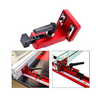New to using Track saw but seems they are all left handed? In that you can’t see blade during cutting and to rip off lengths from a board you have to use left handed or the cut section will be under the track .(not practical for narrow cuts.)
As others have said, pretty much every rail guided saw out there is right handed. You don't reslly need to watch the cut line because the guide rail* keeps it all in line in the same way the rip fence on a table saw does
Plunge saws on rails are primarily designed to break down larger sheets of material into components with minimal edge break out, as you will get on MFC (Contiboard) and the like if you cut without some form of anti splinter device. That's where the anti splinter strip on the rail comes in handy, but if you cut thin strips of material on the outside of this you get two potential problems - on many saws there is no anti splinter protection on the outside of the saw blade, and you need to account for the width if the saw blade kerf when marking or making the cut
By using an add on accessory such as the
Original Waste Side Jig (2.2mm kerf example shown, but other kerfs are available to match your saw blade - different blades have different kerf widths) you can take account of the kerf width of the blade to make accurate size cuts. It works by helping you set the anti splinter strip on the guide rail a kerf width further away from the right hand side of the material, thus making qn accurate cut. TBH with experience you can pretty much eyeball this, I find
Some materials, such as MDF, won't spelch much, and for some materials, such as chipboard flooring a small amount of breakout is acceptable, but where it isn't the rail should be clamped in place and a 1 to 2mm deep scoring cut made before drawing the saw back to the starting position and making a full depth cut (some saws have a built in facility to deal with this)
Another technique for dealing with narrow cuts is to place a piece of same thickness material to the left of the piece you wish to cut and use that to support the guide rail. This works better if you join the two pieces together temporarily with masking tape as narrow steips can move - the key is to support the guide rail and also ensure the narrow piece cannot move whilst you are cutting
Whatever else youneed a flat, stable cutting base to be able to use guide rails accurately and effectively
* - guide rail = track. When Festool (the inventors of this concept) originally introduced these they were called guide rails. Track is a later term from the USA


